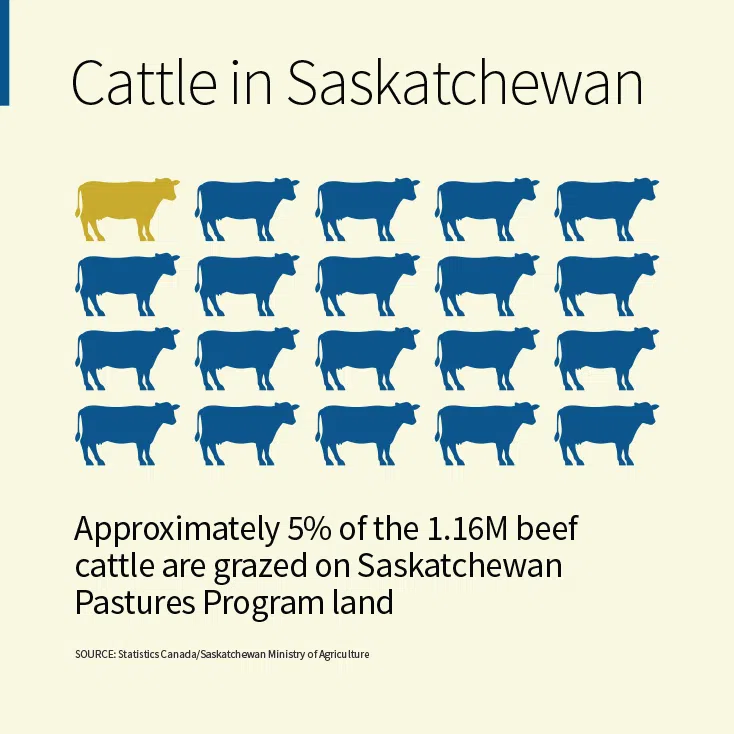
Pasture Land Consultation
There are many options to consider when it comes to the future management of SPP land. The government is committed to engaging in an open dialogue about the future management of the land to help determine how the land best serves the agriculture industry in Saskatchewan.
An online survey will be available from March 27 to May 8 here: https://gos.fluidsurveys.com/s/pastures/
1. Saskatchewan Pastures Program Background
The Government of Saskatchewan recently announced it is ending the Saskatchewan Pastures Program (SPP). This program, created in 1922, was developed to help Saskatchewan’s agriculture industry grow and diversify by providing assistance to small cattle producers. Since then, the agriculture industry has evolved, as have the needs of producers, and the program is no longer necessary. The SPP operates 50 pastures that, in 2015, supported approximately five per cent of the provincial cattle herd. Based on 2011 census data, about 12 per cent (1,300) of Saskatchewan cattle producers use the Saskatchewan Pastures Program.
2. Pasture Lands
Saskatchewan Pastures Program land consists of approximately 780,000 acres located at 50 sites throughout the province. These parcels of land range in size from 3,000 to 76,000 acres. This is in addition to the more than six million acres of grazing land, including more than five million acres of native prairie, the Ministry of Agriculture currently leases to Saskatchewan ranchers.
The SPP land includes native and tame grasslands with varying economic, environmental, and heritage value. While some early evaluations are complete, further assessment will be done before decisions are made about specific parcels of land. The government expects that about one-third of the land will be classified as having high ecological value and, therefore, will not be sold. The remaining lands will be designated as having moderate and low ecological value.
3. How Ecological Value Is Protected through Legislation
Regardless of who owns or manages the land, ecologically important lands will continue to be protected under The Wildlife Habitat Protection Act (WHPA) and The Conservation Easements Act. Land of high ecological value cannot be sold and must be retained by the Crown. This helps to ensure that the ecological health of high-value lands is protected. Land of moderate value may be eligible for sale but only with a Crown Conservation Easement. Under The Conservation Easements Act, there are fines to a maximum of $100,000 for an individual and $500,000 for a corporation, in addition to enforcement options to ensure compliance.
For the most part, WHPA and The Conservation Easements Act accommodate both public and private ownership by recognizing that each parcel of land, as well as its surrounding area, is unique. At the same time, because pastures are large in size, they often contain land with different classifications. For example, the same pasture can contain lands of high, moderate, and low ecological value.
4. How Ecological Value Is Assessed
WHPA protects ecologically sensitive Crown land from sale or development. While land of high ecological value cannot be sold and must be retained by the Crown, land of moderate ecological value can only be sold with a Crown Conservation Easement. Land of low ecological value can be sold without any restrictions.
Land is classified using a tool called the Crown Land Ecological Assessment Tool (CLEAT). The tool uses a model that evaluates land based on a number of different attributes.
Wherever possible, staff verifies CLEAT evaluations by checking them against historical records, and, in some cases, by doing on-the-ground surveys.
5. Considerations and Guiding Principles
There are many SPP land options to consider, including:
- Entering into long-term lease agreements with current patrons, similar to the model adopted when the federal pasture program ended;
- Long-term leases to any interested individuals or groups;
- Selling of eligible land to interested individuals or groups;
- A mix of leases and sales; and
- Dividing the land into smaller, more manageable units (often referred to as ranch units).
Considering each pasture’s unique geographic location, accessibility, and ecological make-up, it is unlikely that a one-size-fits-all approach will work.
The following principles are driving the decision-making process on the future management of SPP lands:
- Existing pasture patrons will be respected throughout the process;
- The ecological integrity of the lands is preserved, including the protection of environmentally sensitive parcels through the application of The Wildlife Habitat Protection Act;
- All land must be managed in a sustainable manner and land will only be severed into smaller grazing units where separation will not jeopardize ecosystem integrity;
- Farmland ownership rules of The Saskatchewan Farm Security Act will be adhered to;
- The province will conduct its duty to consult and accommodate with relevant First Nation and Métis communities where there is the potential to adversely impact Treaty and Aboriginal rights and traditional uses;
- Current and potential social interests (i.e. heritage, tourism, hunting, etc.) be considered;
- Current and potential non-agricultural uses, (e.g. oil and gas activity, sand and gravel reserves, etc.) that occur on these lands are recognized;
- All management options be based on a business model that is reflective of the value of the land and generates an appropriate revenue stream for the public; and
- The disposition of improvements (i.e. corrals, fences, water development, etc.) is considered.


